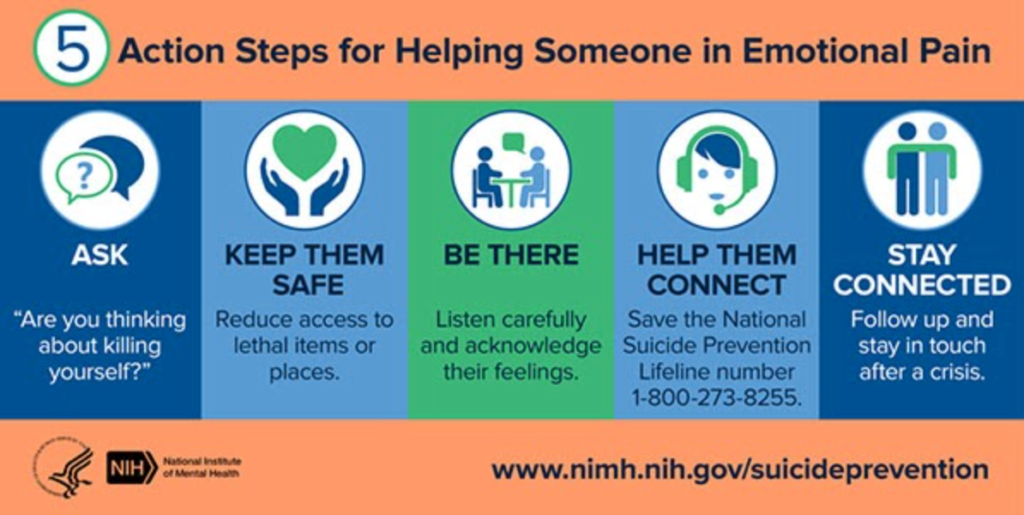Suicide is a very stigmatized topic and often super uncomfortable for people to talk about. But it’s important to talk about because it’s actually the tenth leading cause of death overall in the US. Yearly, it claims over 47,000 lives and is the second leading cause of death for people ages 10-34.
When you hear those statistics, it clicks how imperative it is to have conversations about suicide. Whether it’s sharing resources or stories, it really shines a light on a topic otherwise avoided.
Continuing the suicide prevention conversation
The month of September is National Suicide Prevention Month. As we move forward into October, it’s important to keep the conversations going! We all can help prevent a future suicide.
If that seems like an overwhelming responsibility, don’t worry. We’re here to break down the ways you can do your part in the prevention of suicide in five steps:
Step one: ask and listen
The first thing you’ll do is ask! Research shows that those who are having suicidal thoughts feel such a relief when someone talks about it with them. Acknowledging and talking openly about those thoughts with someone they trust can significantly reduce the thoughts.
It’s a tough question to ask someone: “Are you thinking about killing yourself?” But it’s imperative that you do! Asking about it typically won’t increase risk, so don’t be afraid to ask someone that tough question if you’re suspecting they may have suicidal thoughts.
If you’re unsure what warning signs might mean it’s time to ask, be on the lookout for these things:
- Talking about wanting to die or wanting to kill themselves
- Talking about feeling empty, hopeless, or having no reason to live
- Making a plan or looking for a way to kill themselves, such as searching for lethal methods online, stockpiling pills, or buying a gun
- Talking about great guilt or shame
- Talking about feeling trapped or feeling that there are no solutions
- Feeling unbearable pain (emotional pain or physical pain)
- Talking about being a burden to others
- Using alcohol or drugs more often
- Acting anxious or agitated
- Withdrawing from family and friends
- Changing eating and/or sleeping habits
- Showing rage or talking about seeking revenge
- Taking great risks that could lead to death, such as driving extremely fast
- Talking or thinking about death often
- Displaying extreme mood swings, suddenly changing from very sad to very calm or happy
- Giving away important possessions
- Saying goodbye to friends and family
- Putting affairs in order, making a will
Step two: keep them safe
The second thing you’ll want to do is keep them safe. By reducing the suicidal person’s access to lethal items or places, you can help to keep them safe. Again, this isn’t easy, but if you ask the at-risk individual if they have a plan and they do, remove or disable their lethal means.
Step three: be there
The third thing you should do is be there! Listen, without judgment, to what that individual is thinking and feeling. This goes hand-in-hand with the reason why we ask. It continues the conversation, reducing the suicidal thoughts.
Step four: help them connect
Fourth, help them connect. Keep these numbers saved in your phone. You never know when you may need them:
- National Suicide Prevention Lifeline: 1-800-273-8255
- Crisis Text Line: 741741
Other sources to connect someone with include: family, friends, and/or mental health professionals. When tapping into their network of resources, the individual will feel supported and safe, overall reducing their feeling of hopelessness. That leads us to our final step.
Step five: stay connected
And the fifth thing to do is stay connected. When someone follows up with the at-risk individual, the number of suicide deaths goes down. So, by keeping in touch with the person, you’re helping them through this tough time even after the height of their crisis has passed. It makes a difference to keep that connection with them.
As you digest the information we’ve provided here, try to reduce the pressure associated with it. There can be a lot of pressure to save a life. Show up, be a friend, and have those uncomfortable conversations and you’ll be doing your part.
For a visual guide of the steps we outlined, check out the image below. You might even want to save it in your phone for when you need a quick reminder of the steps to support someone potentially at-risk.

If you or someone you know is going through a tough time, we’re here for you. Contact our team at the Ventura Counseling & Wellness Center today to get started with services.





